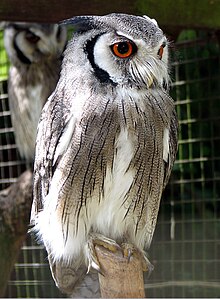
Owls are birds from the order Strigiformes, which includes over 200 species of mostly solitary and nocturnal birds of prey typified by an upright stance, a large, broad head, binocular vision, binaural hearing, sharp talons, and feathers adapted for silent flight. Exceptions include the diurnal northern hawk-owl and the gregarious burrowing owl.

The true owls or typical owls are one of the two generally accepted families of owls, the other being the barn owls (Tytonidae). This large family comprises 230 living or recently extinct species in 24 genera. The typical owls have a cosmopolitan distribution and are found on every continent except Antarctica.
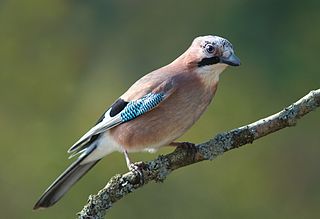
The Eurasian jay is a species of passerine bird in the crow family Corvidae. It has pinkish brown plumage with a black stripe on each side of a whitish throat, a bright blue panel on the upper wing and a black tail. The Eurasian jay is a woodland bird that occurs over a vast region from western Europe and north-west Africa to the Indian subcontinent and further to the eastern seaboard of Asia and down into south-east Asia. Across this vast range, several distinct racial forms have evolved which look different from each other, especially when comparing forms at the extremes of its range.
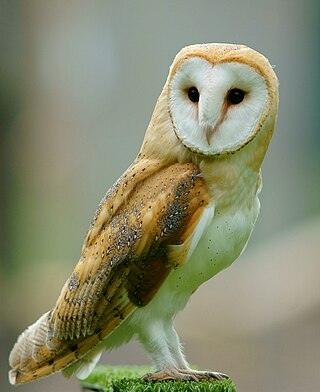
The barn owl is the most widely distributed species of owl in the world and one of the most widespread of all species of birds, being found almost everywhere except for polar and desert regions, Asia north of the Himalayas, some islands of Indonesia, and some Pacific Islands. It is also known as the common barn owl, to distinguish it from the other species in its family, Tytonidae, which forms one of the two main lineages of living owls, the other being the typical owls (Strigidae).

The eastern screech owl or eastern screech-owl, is a small owl that is relatively common in Eastern North America, from Mexico to Canada. This species resides in most types of woodland habitats across its range, and is relatively adaptable to urban and developed areas compared to other owls. Although it often lives in close proximity to humans, the eastern screech owl frequently avoids detection due to its strictly nocturnal habits.

Scops owls are typical owls in family Strigidae belonging to the genus Otus and are restricted to the Old World. Otus is the largest genus of owls with 59 species. Scops owls are colored in various brownish hues, sometimes with a lighter underside and/or face, which helps to camouflage them against the bark of trees. Some are polymorphic, occurring in a greyish- and a reddish-brown morph. They are small and agile, with both sexes being compact in size and shape. Female scops owls are usually larger than males.

The Japanese scops-owl is a small owl species in the family Strigidae, or true owl family. It is a member of the genus Otus, the scops owl genus. It is resident to Japan, China, Korea, and Russia.
The Javan scops owl is a small species of owl living mainly on western Java's high volcanos; local people refer to the owl as Celepuk Jawa. Like most owls, this nocturnal bird also has a strong ability of silent flight.

Wallace's scops owl is endemic to the Sumbawa and Flores islands, in the Lesser Sundas chain of Indonesia. It is not rare in most of its habitat and has no subspecies except for the nominate. It is also known as the Lesser Sunda scops owl. It is named after Alfred Russel Wallace, a British naturalist, explorer, geographer, and biologist.
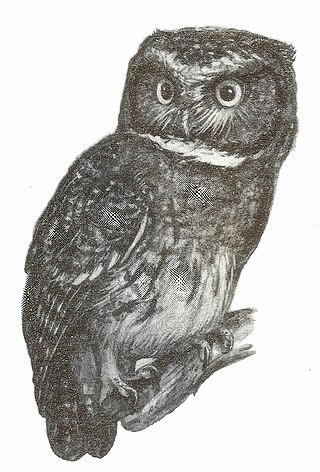
The white-throated screech owl is a small owl found in the Andes of Bolivia, Colombia, Ecuador, Peru and Venezuela.

The Luzon scops owl or the Luzon highland scops owl is a species of scops owl endemic to Luzon, Philippines. Not to be confused with the Philippine scops owl, sometimes referred to as the Luzon lowland scops owl, which is a more common species that shares the same range. The Luzon scops owl, however, is smaller and inhabits higher altitudes than its lowland relative.

The southern white-faced owl is a fairly small owl in the family Strigidae. It is native to the southern half of Africa. It was formerly regarded as a subspecies of the northern white-faced owl but the two are now commonly treated as separate species.
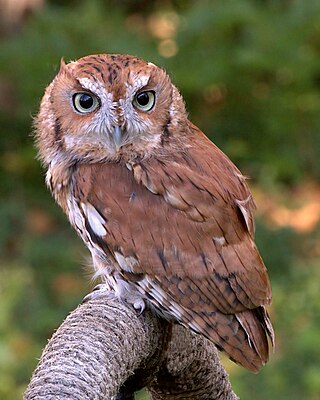
Screech owls are typical owls (Strigidae) belonging to the genus Megascops with 22 living species. For most of the 20th century, this genus was merged with the Old World scops owls in Otus, but nowadays it is again considered separately based on a range of behavioral, biogeographical, morphological, and DNA sequence data.
